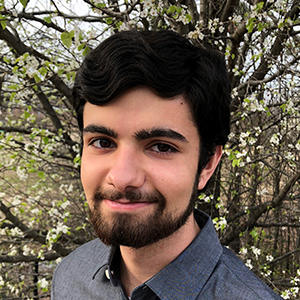NC Museum of Art Reflection
Huang Fellow Paul Sabharwal Reflects on a Visit to the North Carolina Museum of ArtThe night before our visit to the North Carolina Museum of Art, someone mentioned that they were excited to see some works of modern art held in its collections. By this point, the Fellows had been together for three and a half weeks, so we all knew that excessively animated discussions on any topic whatsoever were not only possible but expected. Launching from a question of whether modern art was drastically overvalued, the group argued for a couple hours about what defines art and where the value of art lies. Does it come from the original artist or from the work’s history of interpretation by society? Does it require skill or a specific intentionality? By the time we finally decided to call it a night, we hadn’t gotten any closer to an answer.

The next day’s museum tour began with a trip to the NCMA Conservation lab. To my surprise, as the conservators described the procedures they used to analyze and restore paintings after centuries of decay, I found myself hearing the exact same techniques I had learned about in chemistry class but in a context I had never considered before: X-ray spectroscopy, mass spec, radiography.This was some serious scientific equipment, the same kind used by many of the labs we worked in. At the same time, the efforts of the conservators brought up the same questions we had been discussing the night before about the nature of art. In one instance, it was discovered that a woman’s dress in an old work had been painted over to be blue instead of red, and the conservators had decided to restore it to original state. However, hidden behind that decision, I realized, was a statement about the value of art. It says that the primary value of art comes from the original author. What if it came from the art’s history in society? It could instead be argued that “conserving” the art should retain the later blue paint-over. These questions would persist throughout the rest of the tour of the conservation lab and the rest of the museum. A commanding statue of King Saul they were restoring is a masterpiece of skill, however I was surprised to hear that all credit for statues of its sort goes to the artist who designed it, and not to the actual sculptor who crafted it out of stone. Later on, as we saw a decorated sarcophagus, I came to the realization that while it seems natural to call the intricate designs art today, they weren’t actually intended to be so in the first place –after all, would we think of an ornate gravestone as art? Several of us who had been discussing all of these questions the night before continued our discussion, lagging behind the rest of the group as we tried to extend the conversation about each work of art.

Many decisions in lab are made using a very logic-based mindset: What will have the highest expected value of giving good data? How can we justify using this expensive machine on a grant application? Before the NCMA trip, I assumed that art decisions would be the exact opposite, based entirely on intuition and feelings. However, I was surprised to see that this wasn’t always the case. When deciding what to restore or not restore, or how to do it, conservators actually use pretty much the same approach we would use in a lab inquiry by reasoning through the alternatives and seeking advice from collaborators and experts around the world. It seemed very scientific. Of course, beneath it all, there is still the level of intuitive decision-making addressing those value questions from earlier or why we have decided to spend so much money on restoring art in the first place. This isn’t a question I can answer logically, but one where I can only feel that there’s something important about art that gives it value. Most interestingly, this experience led me to wonder what the ‘hidden’ intuitive decisions are in my science research. Sure, I’m working on Staphylococcus proteins in order to get a better understanding of how they fold and operate in the bacteria, in order to learn about how these bacteria harm humans, in order to … and so on.If you keep asking, though, there’s still that level of intuition: what are the priorities of our society that cause us to allocate resources the way we do? Decision-makers have come up with a lot of possible metrics to evaluate and compare how to spend money (expected return, years of life saved, risk, quality of life, etc.). In the end, though, we are forced to decide what we as a society value, and no amount of accounting can help. Higher total wealth or more income equality? More natural areas or more affordable housing? Science or art? This is what all of our discussions about art were really about –what do we value? Much like before, I couldn’t come to a conclusion on any of the questions. However, it did ram home that my everyday decisions, even those that seem entirely controlled by logic, are implicit statements about what I value in the world, something I will do my best to never forget.
Paul Sabharwal, Huang Fellow ’22
 Paul is from Richmond, Virginia and is planning to study Chemistry and Computer Science.
Paul is from Richmond, Virginia and is planning to study Chemistry and Computer Science.

